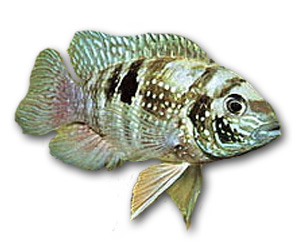Blue Acara

Quick Stats
| Size | About 8" (20cm) |
|---|---|
| Tank | 100 litres + |
| Swimming Area | All |
| Ph | 6.5 to 7.5 |
| Temperature | 73ºF to 82ºF (22-28°C) |
| Food | Flakes, Bloodworm and Cichlid Pellets |
Common Name:
Blue Acara, Blue Cichlid.
Distribution:
Central and Northeast South America in the countries of Venezuela, Columbia and Panama.
Colouration:
A very beautiful fish! The sides have a base color of Yellow to Brown with hints of Green or Blue in it. The belly area is also this color but of a paler hue. The back looks to be an army Green in color. The scales of the Acara each have a shinny Blue or Blue-Green spot that give the whole body an iridescent view. The sides are marked with a series of five to eight up and down bands with the forth band having a large Black blotch in it. The iris in the eye is Yellow. The gill covers and cheeks have many metallic dots in same sheen of Blue or Green as the scales. The caudal or tail fin is mostly clear with a hint of Red in it. The other fins all have a Blue Green sheen, with the dorsal being outlined in Red. The lips are a pale Blue in color. During breeding the sides are marked with a series of six to eight side to side rows of Green to Golden dots. The females are generally the same color overall, without the extended fins.
Lifespan:
Up to 10 years.
Maintenance:
10 - 20% weekly water changes. Typical to most Cichlids the Blue Acara is a hardy and easy to care for fish if their needs are met.
Feeding:
Not a fussy eater and will accept flake food as well as live. Best feed Cichlid Pellet food.
Substrate:
A sandy bottom is best. As with most cichlids, they like to dig.
Tank Decor:
The tank should be large and have plenty of caves and nooks to hide in. Driftwood, rockwork and live or plastic plants are also helpful.
Filtration:
Provide good filtration and do frequent water changes, as they do not do well if the water conditions deteriorate.
Biotype:
Found in still and sluggish waters of the local river basins.
Breeding:
Said to be very easy. Temperature should be 75ºF to 82ºF . The eggs are small and adhesive. The female will lay 150 to 250 eggs in the selected place, which may be in the open in a carefully prepared place on bottom of the tank, on a flat stone or a big leaf of a plant . The eggs hatch in three days and the fry will be free swimming after one week. Both parents will take care of the fry and can become very aggressive towards other fish. They should be fed with artemia (baby brine shrimp) for first 7-10 days. A single pair will spawn several times a year sometimes even when still caring for a earlier brood of young.